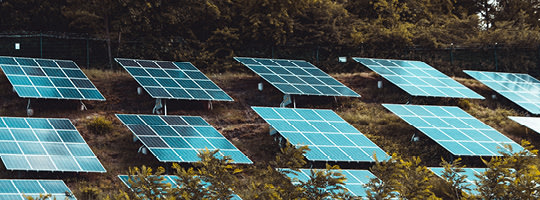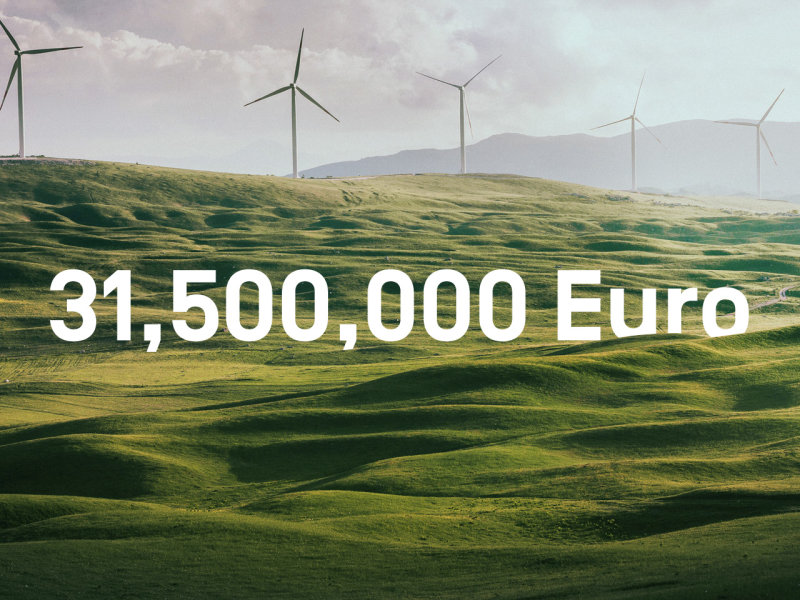Together with you, we want to make money part of the solution. And as our impact investments play an important role in this, we have now gone one step further and increased them substantially while also adding three additional green bonds. Read on to find out exactly what this means and which projects will be financed.
Money should make a contribution towards positive change and a good future for us all. Which is why we are financing – together with you – renewable energies, forest conservation and social projects in the Global South and offsetting massive amounts of CO₂. Part of the positive impact comes from investing in green and social bonds that are financed through customer deposits.
These bonds are an important lever for change. This is why we have now gone one step further and increased our impact investments by more than 50 percent. Specifically, this means that Förderbank NRW green bonds (around €10 million), the Nordic Investment Bank green bond (increased to over €4 million) and the Nederlandse Waterschapsbank N.V. social bond (€6 million) will be joined by the following new impact investments: 5 million euros in the German state’s green bond, €5.4 million in the KommuneKredit green bond and €1 million in the infrastructure bond issued by Hamburg public transport operator Hochbahn AG.
Accordingly, our total impact investments now amount to €31,500,000, which can now be used to finance renewable energies, climate-friendly transport, affordable housing and sustainable communities.
Sounds great, but what exactly is a bond?
Bonds are securities that are traded on the stock exchange. They can be acquired by private investors (like you) or institutional investors (like Tomorrow or our partner Solaris SE). Financial institutions (in this case, for example: Förderbank Nordrhein-Westfalen, the Nordic Investment Bank or Nederlandse Waterschapsbank N.V., which issue the green and social bonds) raise capital in this way to refinance loans. Here, they must pay back the capital to the creditor (in this case Tomorrow/Solaris SE) after a specific term, together with interest.
Details about the German state green bond
Germany’s green bond is geared towards financing the country’s sustainability strategy, which among other things is committed to the United Nations Sustainable Development Goals (SDGs) and the 1.5-degree target set out in the Paris Climate Agreement. When, in order to comply with these goals, the German state issued green bonds for the first time in 2020, Tomorrow participated to the tune of €5 million. This means that your deposits are helping to move towards more sustainable, resource-friendly and low-CO₂ business practices in Germany and worldwide.

How is the money invested?
The bulk of the investments is used to drive the shift towards more environmentally friendly mobility (SDG 9 & 13). For instance, 58 percent of funds from the green bond is used to further develop bicycle lanes, public transport and e-mobility. Another 10 percent is channelled into renewable energies, thermal installation and energy-efficient heating and construction (SDG 7 & 11). As well as this, three percent goes to ecological agriculture and forestry and a further five percent to research and education (SDG 4).
24 percent of investments also help to finance international cooperations for climate projects, environmental protection and conservation (SDG 13, 16 & 17 ). Here at Tomorrow, the climate justice aspect is particularly important. This is because the climate crisis tends to take a greater toll on people in the Global South even though they have contributed least to the problem. State bonds are used, for example, to help finance the work of the German Society for International Cooperation (GIZ), which is active in over 120 countries, bringing about lasting improvements to the quality of life of local people (SDG 1, 8, 10).
Details about the KommuneKredit green bond
The green bond comes from KommuneKredit, a state bank that has been issuing green bonds since 2017. Its aim is to use the Danish and international financial markets to finance the sustainable transition in Danish municipalities. The investment funds are used for the express purpose of providing Danish municipalities and cities with loans for sustainable and social projects. Since 2017, KommuneKredit’s “Green Committee” has granted more than 410 loans equivalent to more than €3 billion in total. All supported projects are geared explicitly towards the United Nations Sustainable Development Goals (SDGs).

How is the money invested?
In 2020, 62 percent of investments were used to promote regional and local climate protection measures and for efficient, resource-friendly energy and heating (SDG 11) . In addition, 31 percent of funds are channelled into modernising waterworks and sewage systems (SDG 6). Seven percent are used for developing public transport, both on land and on water. As Denmark has over 7,300 kilometres of coastline and over 80 inhabited islands in the North and Baltic seas, protecting its coastline is a priority, for instance in the form of dykes and sluices. At the same time, the ferries are being converted to hybrid drive with a view to minimising CO₂ emissions on waterways as well and to protect the coastlines and their valuable flora and fauna (SDG 14). Local authorities also receive loans for important social infrastructures, such as energy-efficient construction or modernising schools, municipal buildings, sports facilities and retirement homes (SDG 9).
Details about Hochbahn AG’s infrastructure bond
The infrastructure bond issued by Hochbahn AG is helping to finance the transition towards more environmentally friendly mobility in Hamburg. All supported projects are geared towards the United Nations Sustainable Development Goals (SDGs). With over €1 million, Tomorrow participated in the first infrastructure bond of its kind in its native Hamburg, which will make a total of €500 million available for Hochbahn traffic projects. Funds from this investment will be used to finance 50 new trains and 160 buses and to repair existing underground railway lines.

How is the money invested?
The Hamburg metropolitan region is home to 5.3 million people, of which almost one million people commute every day, causing the bulk of CO₂ emissions in city traffic. This is because, on average, 65 percent of these people commute by car. Hamburg has a climate plan for a climate-neutral city that also involves cutting 1.4 million tonnes of CO₂ in the traffic sector. The projects financed with the green bond are part of the “Hamburg-Takt” strategy that aims to shift mobility from private cars to public transport. By 2030, the proportion of trips that can be made by bus and train is to increase from the current 22 percent to 30 percent, thereby making a key contribution to the city’s climate neutrality target. The aim is for Hamburg’s elevated railway to be climate-neutral by 2030 at the latest.
More environmentally friendly mobility in cities not only means fewer climate-damaging CO₂ emissions but also less air and noise pollution for city dwellers. As less parking space will be needed, there will be more room for bicycle lanes, footpaths, parks and playgrounds – all of which increase the quality of city life in urban spaces.
To find out even more about our green and social bonds, click here.
